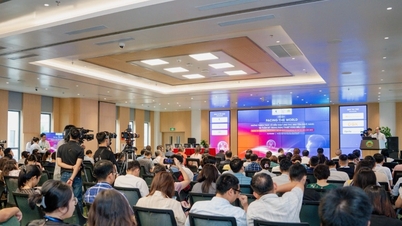Distinguishing between surgical methods
The development of medical technology has given nearsighted people many options to “say goodbye to glasses”, but has also confused many people with a series of names such as Femto LASIK, SmartSight, ReLEx SMILE or Phakic ICL. So how are these methods different and who is suitable for each technique?
Refractive eye surgery is a surgical intervention to correct refractive errors such as nearsightedness, farsightedness, astigmatism and presbyopia.

Experts have answered many questions surrounding nearsightedness surgery (Photo: Thanh Dong).
In the online seminar "Choosing a safe cataract surgery method" organized by Dan Tri newspaper, experts analyzed and gave in-depth advice on this issue.
According to Associate Professor, Dr. Nguyen Duc Anh, former Head of Refractive Surgery Department (Central Eye Hospital), currently refractive surgery is divided into two main groups.
Group 1: Surgery with corneal flap (LASIK, Femto LASIK or SmartFemto)
The doctor will create a thin flap on the cornea with a mechanical knife or femtosecond laser, then use an excimer laser to correct the refractive error and then replace the corneal flap.
“The advantage of this method is that it is quick and vision improves significantly after just a few days, but patients need to limit rubbing their eyes or participating in activities that can cause collisions for about the first month,” said Associate Professor Duc Anh.

Associate Professor, Dr. Nguyen Duc Anh, former Head of Refractive Surgery Department, Central Eye Hospital (Photo: Thanh Dong).
Group 2: Surgery without creating corneal flap (ReLEx SMILE, SmartSight, CLEAR, SILK...).
Instead of cutting a flap, the doctor only makes a small incision of a few millimeters to separate and withdraw a thin layer of tissue inside the cornea to correct refraction.
Flapless methods help reduce dry eye, are less invasive, and allow patients to return to normal activities sooner. However, they are often more expensive and require modern equipment and experienced doctors.
Associate Professor Duc Anh emphasized: "The names may vary depending on the machine manufacturer, but in essence, they are all based on the same principles of modern refractive surgery, the only difference is in the way of creating and taking corneal tissue."
Hong Ngoc General Hospital is one of the few domestic units that can simultaneously perform three new generation refractive surgery technologies: SmartFemto, SmartSight and Phakic ICL.
This allows the doctor to choose the optimal option based on each person's eye characteristics.
SmartFemto is often used as a safe choice for people with thick corneas and not too high nearsightedness and astigmatism.
According to Dr. Dinh Thi Hoang Anh, Head of the Ophthalmology Department (Hong Ngoc General Hospital), "many people can return to work after three days after SmartFemto surgery, and their eyes will be completely stable after about two to three weeks, depending on each person's condition."

Dr. Dinh Thi Hoang Anh, Head of Ophthalmology Department, Hong Ngoc General Hospital (Photo: Thanh Dong).
Meanwhile, SmartSight uses a new generation femtosecond laser with extremely high precision, allowing for quick operation, limiting dry eyes and suitable for people with an active lifestyle. “Because there is no flap, patients can return to sports activities, especially sports with collision or ball use, sooner than with SmartFemto,” Dr. Hoang Anh shared.
SmartSight is considered a more modern version of ReLEx SMILE, inheriting the principle of surgery through small incisions but with improvements in speed and laser energy control.
Besides the two laser surgery groups, Phakic ICL (intraocular lens surgery) is an option for people with high myopia or thin corneas, who are not eligible for laser surgery.
According to Dr. Hoang Anh, Phakic ICL is especially suitable for people with nearsightedness from -8 to -18 diopters, or corneas too thin for laser surgery.
The biggest difference of Phakic ICL is that it does not affect the cornea, thus completely preserving the natural structure of the eye.
“The lens is placed in the anterior chamber, acting like a 'micro-contact lens' in the eye, providing refractive correction without ablating the cornea.
However, patients must be examined in depth to assess the depth of the anterior chamber and the number of endothelial cells before treatment is prescribed," Dr. Hoang Anh shared.
Thus, despite the different names, myopia surgery techniques all aim at the same goal: helping patients see clearly without glasses, with different levels of intervention and recovery times. Choosing the appropriate method should be based on eye characteristics and the specialist's instructions, rather than on feelings or advertising the "latest" technology.
After myopia surgery, eyes are weak and prone to re-myopia?
Although refractive surgery is becoming more and more popular, many people still wonder: "Is the surgery safe?", "Will myopia recur?", "How long will it take to see clearly again?", or "Do I need to abstain from anything special?". These questions were also specifically answered by experts during the discussion.
Is nearsighted surgery safe?
According to Associate Professor, Dr. Nguyen Duc Anh, current near-eye surgery technologies such as SmartFemto and SmartSight are highly accurate and have been approved by the US Food and Drug Administration (FDA).
“If previously the biggest risk of complications was corneal flap deviation or prolonged dry eyes, with new generation laser technology, these risks have been significantly reduced,” he affirmed.


At facilities with adequate equipment and strict aseptic procedures such as Hong Ngoc General Hospital, all surgeries are performed in a positive pressure operating room, which helps to minimize bacterial invasion. Each surgery only lasts 10-15 minutes and the patient can go home the same day.
“Refractive surgery is currently considered one of the safest interventions in ophthalmology, as long as patients are carefully screened and comply with post-operative care,” Associate Professor Duc Anh emphasized.
Dry eyes or blurred vision after surgery is a cause for concern?
According to Dr. Dinh Thi Hoang Anh, feeling dry or slightly gritty in the eyes is a normal reaction after surgery because the corneal nerve endings are temporarily cut during the laser process.
“This feeling will decrease rapidly within a few days, and will almost completely disappear after two to three weeks. At Hong Ngoc, we always instruct patients to use artificial tears properly and maintain the habit of blinking enough to avoid prolonged dryness,” Dr. Hoang Anh shared.
Associate Professor Duc Anh also added that the slight blurriness in the first few days is due to the eyes adapting: "Vision usually reaches 8-9/10 immediately after surgery and is completely stable after about two weeks, depending on the individual and the chosen method."
Will myopia recur after surgery?

According to Associate Professor, Dr. Nguyen Duc Anh, current near-sighted surgical technologies such as SmartFemto and SmartSight are highly accurate (Photo: Thanh Dong).
This is the question that most people are interested in. According to Associate Professor Duc Anh, nearsightedness surgery does not change the genetic "gene", so the possibility of nearsightedness recurrence can still occur if the patient works with the screen for a long time, lacks sleep or uses the eyes too much.
“Recurrence is not due to a failed surgery, but due to continued pressure on the eye after surgery. This is similar to a disease that has just been cured but then relapses because of improper care,” he explained.
Hong Ngoc Hospital currently applies a 5-time periodic re-examination regime (1 day, 1 week, 1 month, 3 months and 6 months) to monitor vision and remind patients to adjust their screen viewing habits, light and sleep.
When can I return to normal activities and work?
According to Dr. Hoang Anh, people who have surgery with SmartFemto can usually return to work after 3-5 days, while SmartSight allows for faster recovery because it does not create a corneal flap.
“We advise patients to wear protective glasses when going out, avoid dust and smoke, not to wear eye makeup for the first two weeks and get enough sleep to allow the eyes to recover optimally,” the expert instructed.
Associate Professor Duc Anh also noted that the most important factor is not surgical technology but post-operative care.
“If the patient complies with follow-up visits and proper care, the complication rate is almost zero. Surgery only accounts for 10% of success, the remaining 90% depends on the patient's cooperation,” he emphasized.
Does cataract surgery affect long-term health?
According to experts, refractive surgery only affects the corneal layer, not the deeper structures such as the lens or retina. However, a general eye examination before surgery is required to rule out underlying diseases such as retinal degeneration or glaucoma.
At Hong Ngoc General Hospital, the pre-operative examination process lasts about 2 hours with more than 10 measurement steps: corneal map, thickness, dry eye, fundus, contrast sensitivity, objective and subjective refraction... helping the doctor accurately determine the condition of each eye before making an indication.
Thanks to this strict screening process, the rate of recurrence or prolonged dry eye after surgery at centers applying SmartFemto and SmartSight technology is recorded at less than 1%.
Notes before and after myopia surgery for best results
According to Associate Professor, Dr. Nguyen Duc Anh, patients should only have surgery when they meet three criteria: stable vision, thick enough cornea, and no underlying disease in the fundus of the eye. “Surgery should not be performed because of trends or advertisements for the latest technology. Healthy eyes are more important than taking off glasses a few months early,” he advised.

Pre-operative preparation and adherence to post-operative eye care principles are important (Photo: Thanh Dong).
Dr. Dinh Thi Hoang Anh also emphasized the importance of compliance with post-operative check-ups and care.
According to Dr. Hoang Anh, after surgery, patients should maintain good habits such as:
- Wear protective glasses when going out to avoid dust and smoke.
- Get 7-8 hours of sleep every day to help your eyes regenerate cells.
- Avoid using phone or computer for too long in the early stages.
- Use artificial tears regularly, using the correct type prescribed by your doctor.
- Do not rub your eyes even if they feel a little gritty.
“Keeping your eyes healthy is not just a matter of a few weeks after surgery, but a long-term journey. Consider eye care as a lifestyle habit, not a temporary task,” Dr. Hoang Anh shared.
Both experts believe that patients need to keep a clear mind before making a decision. A thorough examination and consultation at a reputable facility with full measuring equipment such as corneal mapping, dry eye measurement and fundus examination will help determine the appropriate method.
“Myopia surgery is a modern option, but it is only truly meaningful when the patient understands their eyes and knows how to take care of them after surgery,” Associate Professor Duc Anh concluded.
Source: https://dantri.com.vn/suc-khoe/nhung-dieu-quan-trong-can-biet-truoc-khi-quyet-dinh-mo-can-20251104144346277.htm



![[Photo] Chu Noodles - the essence of rice and sunshine](https://vphoto.vietnam.vn/thumb/1200x675/vietnam/resource/IMAGE/2025/11/11/1762846220477_ndo_tl_7-jpg.webp)



![[Photo] Prime Minister Pham Minh Chinh receives Lao Minister of Labor and Welfare Phosay Sayasone](https://vphoto.vietnam.vn/thumb/1200x675/vietnam/resource/IMAGE/2025/11/11/1762872028311_dsc-2246-jpg.webp)






















































































![Dong Nai OCOP transition: [Article 3] Linking tourism with OCOP product consumption](https://vphoto.vietnam.vn/thumb/402x226/vietnam/resource/IMAGE/2025/11/10/1762739199309_1324-2740-7_n-162543_981.jpeg)








Comment (0)